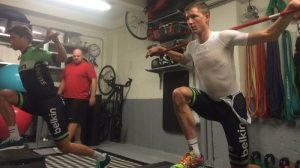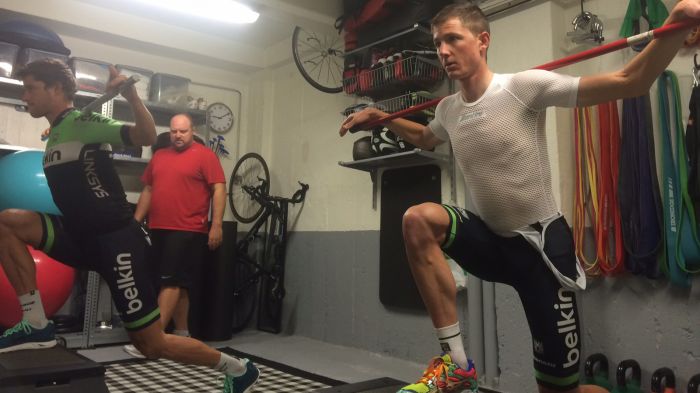It's no secret that cycling requires strength: leg strength, arm and shoulder girdle strength and core strength (and stability) are often overlooked parts of cycling prowess. I've personally seen the benefits of combining moderate strength training with cycling, and I've seen clients, athletes and patients benefit greatly from increased strength.
“But cycling is and aerobic sport” I hear you cry. You're 100% right, cycling (aside from track sprinting) is predicated on aerobic conditioning and capacity. However, no sport can exist in a strength vacuum;, and cycling is no exception; lack of strength (especially functional strength) is a short road to injury and underperformance. Your body needs strength and stability to be able to efficiently utilize its aerobic capacity. The problem with strength and stability is that it's exactly like your aerobic capacity in the idea that if you don't use it you lose it. I've talked about strength training and building strength in weightlifting for cyclists part 1 and part 2, and detailed in my Raw Strength Modular training plan, but an important part of strength training is maintaining the gains made during those winter sessions. That can be tough for a couple reasons, which I'll explore in today's podcast.
Click through for the show notes and learn how to maintain those winter strength gains through the year and set yourself up for even bigger gains next year.
Podcast: Play in new window | Download (Duration: 48:37 — 89.0MB)
Subscribe: RSS
 Maintaining Strength Gains – Show Notes
Maintaining Strength Gains – Show Notes
Major hormonal players in aerobic exercise: cortisol (increased with aerobic exercise, catabolizes muscle, suppresses testosterone, IGF-1, and hGH.) Also decreased DHEA (testosterone precursor) and increased adrenaline hormones. Cortisol mobilizes fat, proteins from muscle and glucose to fuel the body and respond to stresses via (sympathetic) fight or flight response.
![]() Supplementing with 4 grams of BCAAs and 6 grams of glutamine, 1 gram of vitamin C to combat cortisol build-up and stimulate anabolic pathways.
Supplementing with 4 grams of BCAAs and 6 grams of glutamine, 1 gram of vitamin C to combat cortisol build-up and stimulate anabolic pathways.
Strength training combats cortisol dominance by increasing HGH, IGF-1 and testosterone.
Links of studies cited in the podcast:
Timing of strength training: Generally before an easy/aerobic day (strength training will inhibit high-intensity aerobic work for a day or so post exercise) or before a rest day.
Stripped down strength training during the same period of time:
At home: Goblet squats, single leg deadlifts, calf raises, lunges/walks, cross lunges, kettlebells (swings, Turkish getups), bridges and variations, renegade rows, variety of swiss ball work, core stability
[easyazon_link identifier=”B000VDTEDA” locale=”US” tag=”taicoaandthed-20″]Swiss Ball[/easyazon_link] [easyazon_link identifier=”B0041G3ZK6″ locale=”US” tag=”taicoaandthed-20″]Adjustable Weights[/easyazon_link]In the gym: Leg press, hack squat, deadlift, squats
Sets and reps: 3×10 or 3×12 sets/reps. Near exhaustion at the end of 3rd set. Builds muscular endurance and strength, increases muscle fiber size and therefore power/strength. For track riders, consider 1-2 days/month of neuromuscular strength training at 3×4 sets/reps to exhaustion.
On bike work: force work, ME work to “integrate” strength work into your riding.
Take home Point: Work strength training into your routine at some point during the season to keep strength gains from the off-season. Do it in such a way that it doesn't impact your high-quality interval days to get the most out of it.
If you enjoyed this episode, please do me a favor and head over to the Tailwind Coaching Podcast on iTunes and rate it 5 stars. A positive review helps the podcast move up the ratings, reach more listeners, and help more people get stronger, faster and fitter. Don't forget to post any questions to the Tailwind Coaching Facebook page, on the Tailwind Coaching forums, contact me via email or leave a comment below. Don't forget to support our sponsors and help to keep this podcast free, help me to get this information to more people and help grow the cycling community.
I encourage you to subscribe to the Tailwind Coaching Newsletter to get my best coaching tips delivered to your inbox, along with a free bonus training plan, updates, and exclusive discounts.
If you're looking for a complete training solution, you can pick up your training plans by checking out my modular training plans in my online store. You should be thinking about fall fitness since those late season races and gran fondos will be here before you know it. Get a head start building fitness and thinking about cyclocross, climbing, sprinting or preparing for a century ride. Let me help you out by providing your training path to glory!
[wdsm_ad id=”5402″ class=” aligncenter” ]
